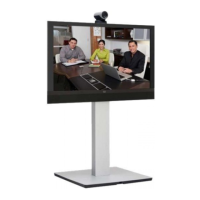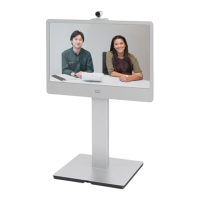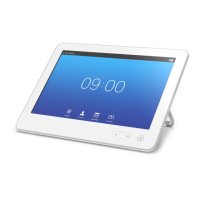D14637.10 Profile C20 and Quick Set C20 Administrator Guide TC6.1, APRIL 2013. www.cisco.com — Copyright © 2010-2013 Cisco Systems, Inc. All rights reserved.
58
Cisco TelePresence System Quick Set C20 and Profiles using C20 Administrator Guide
Conference [1..1] VideoBandwidth PresentationChannel Weight
The available transmit video bandwidth is distributed on the main channel and presentation
channel according to "MainChannel Weight" and "PresentationChannel Weight". If the main
channel weight is 2 and the presentation channel weight is 1, then the main channel will use
twice as much bandwidth as the presentation channel.
Requires user role: ADMIN
Value space: <1..10>
Range: 1 to 10.
Example:
Conference 1 VideoBandwidth PresentationChannel Weight: 5
Conference [1..1] PacketLossResilience Mode
Set the packetloss resilience mode. This configuration will only take effect for calls initiated after
the configuration is set.
Requires user role: ADMIN
Value space: <Off/On>
Off: Disable the packetloss resilience.
On: Enable the packetloss resilience.
Example:
Conference 1 PacketLossResilience Mode: On
Conference [1..1] Presentation Policy
Control how the presentation service is to be performed.
Requires user role: ADMIN
Value space: <LocalRemote/LocalOnly>
LocalRemote: The presentation will be shown locally and sent to remote side.
LocalOnly: The presentation will only be shown locally.
Example:
Conference 1 Presentation Policy: LocalRemote
Conference [1..1] Presentation RelayQuality
Not applicable in this version.
Conference [1..1] Presentation OnPlacedOnHold
Define whether or not to continue sharing a presentation after the remote site has put you on
hold.
Requires user role: ADMIN
Value space: <Stop/NoAction>
Stop: The video system stops the presentation sharing when the remote site puts you on
hold. The presentation will not continue when the call is resumed.
NoAction: The video system will not stop the presentation sharing when put on hold. The
presentation will not be shared while you are on hold, but it will continue automatically when
the call is resumed.
Example:
Conference 1 Presentation OnPlacedOnHold: NoAction
Conference [1..1] Multipoint Mode
Define how the video system handles multiparty video conferences.
If registered to a Cisco TelePresence Video Communication Server (VCS), the video system
can use the MultiWay network solution. MultiWay requires that the video network includes
a multipoint control unit (MCU). If registered to a Cisco Unified Communications Manager
(CUCM), the video system can use the CUCM conference bridge. Both Multiway and the CUCM
conference bridge allows you to set up conferences with many participants.
Requires user role: ADMIN
Value space: <Auto/Off/MultiWay/CUCMMediaResourceGroupList>
Auto: If the MultiWay service is available, MultiWay is used for multiparty conferences. If the
service is not available, Multipoint Mode is set to Off automatically.
Off: Multiparty conferences are not allowed.
MultiWay: Multiparty conferences are set up using MultiWay. The Multipoint Mode will be
set to Off automatically if the MultiWay service is unavailable, for example when a server
address is not specified in the NetworkServices MultiWay Address setting.
CUCMMediaResourceGroupList: Multiparty conferences (ad hoc conferences) will be hosted
by the CUCM configured conference bridge. This setting is provisioned by CUCM in a CUCM
environment and should never be set manually by the user.
Example:
Conference 1 Multipoint Mode: Auto

